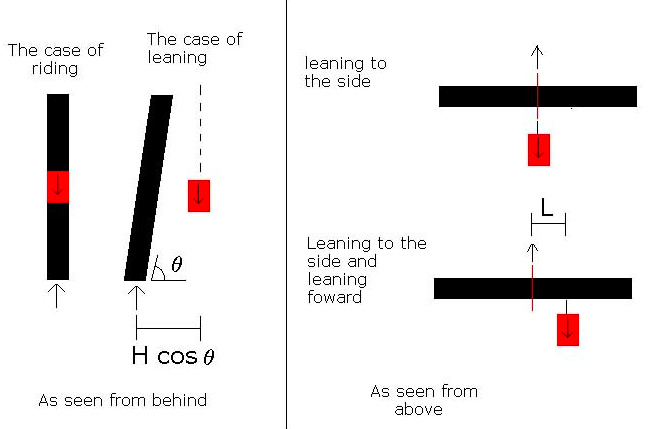Riding
and Turning
"A Unicycle is inherently an unstable
system in three dimensions." - Sheng This is not
something that beginners want to hear when trying to learn how to ride.
In my experience it takes people anywhere from 3 days to 3 weeks,
months, years or maybe even never, to ride a unicycle without
support. For many people it is all in the mind, because they have to
get over the fact that there is only one wheel. Others just have to
find their inner balance. There really isn't anything linear about the
unicycle and that is partly why it is considered to be so hard to
learn. YOU are the steering wheel, YOU are the brakes and YOU are and
what makes it go.
As you can see from the video, I free mount, ride for a while, turn
a few times and then ride back and dismount. What you may not have
noticed was the careful physics behind each of those simple looking
movements.
To free mount a unicycle, put your butt on the seat, place your foot on the lowest pedal first, push forward with your body so that the wheel starts to roll forward and then place your other foot on the other pedal. The picture below shows a good and bad example of mounting from the book, Unicycling: First Steps - First Tricks.

BAD: High Centered. You're
Stuck. GOOD:
Balanced. Ready to Ride!
The person following the bad example did not balance their weight
correctly and instead kept all of their weight in the center. Keeping
your weight in the center leaves you no room to navigate. Think about a
person walking on a tight rope; they have a long pole in order to
balance themselves or they stick out their arms. If the tight ropest
held the pole straight up and down or kept their hands to their sides,
it would be much more difficult and they would probably fall. A
unicyclist does the same thing. If you've ever watched someone ride the
unicycle, you'll see that they rarely stay still and their arms are
waving in all directions. These movements are actually helping the
rider stay balanced. To ride straight you need to have the same weight
on each side and your center of gravity is over the seat.
Turning
Just when you think you've got it, someone throws you a curve ball.
After you've learned how to ride straight, the next thing to learn is
how to turn. Turning can be especially tricky for some people,
especially those still not able to get over the fact of the one wheel.
In order to turn you have to shift your center of gravity away from the
seat. This could directly result in falling if done wrong.

http://www.unicyclist.com/forums/showthread.php?s=&postid=81825#post81825
If you shift your center of gravity to the right, you will turn to
the right and likewise you will turn left if you lean to the left. As
the picture above shows, you also have to lean forward. You can see an
example of this in my video of Riding and Turning. When I turn, I do
not keep my upper body straight up. The radius of the circle my head
makes it much smaller than the radius of the circle my tire makes. I
only demonstrated a right turn, but it is the same thing for a left
turn.
Idling
"The Unicycle's postural
stability can be achieved at a fixed place by moving forward and
backward with wheel's small average moving velocity near to zero." -
Sheng
In other words, when you are idling, you are going back and forth
slowly while staying vertical. Stability is impossible when you are not
moving, there is always some movement going on in order to stabilize
yourself on the unicycle. When you are moving you have control of the
unicycle, so when you're idling, you are oscillating between a
controllable and uncontrollable state. As you can see from my video, my
head pretty much stays in the same place, I just shift my weight to go
backwards and forwards.
